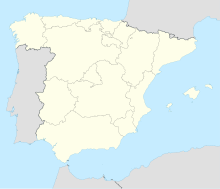Leguaseca dam
Coordinates: 43 ° 6 ′ 18 ″ N , 7 ° 7 ′ 48 ″ W.
The Leguaseca dam was a concrete dam in Spain that was built in 1958 and destroyed in 1987. The dam , which was also called "Fonsagrada dam", was in the Fonsagrada district ( Lugo province , Galicia ) near Vigo in Spain .
The dam
The dam wall was a pillar dam (subtype: vaulted dam wall ) and consisted of several thin concrete vaults standing next to each other, which were stretched between pillars. It was 20 m high and 70 m long. The building site consisted of rock. The reservoir of this dam was relatively small; it only held 100,000 cubic meters. According to other information, it was filled with 16 AF ( acre-feet ) , which would correspond to around 20,000 m³.
Failure of the dam
The dam broke in March 1987. A vault between two pillars broke and a 7 m² hole was created through which the reservoir emptied. At the time of the failure, the reservoir was only sparsely filled. Still there were seven dead.
causes
After the accident, the concrete was examined; physical-mechanical, hydraulic and chemical tests and investigations were carried out to find out the causes. The result was that the quality of the concrete had deteriorated significantly. Due to the aggressive acid and sulphate-rich reservoir water and the penetrating seepage water, the concrete had aged and the reinforcement was rusted. Ettringite and salts had formed in the cement . In addition, there were destructive effects due to the interaction between frost and thaw and the influence of solar radiation, which led to strong temperature tensions.
literature
- M. Guerreiro, R. Fernandez Cuevas, MJ Guerreiro, G. Gómez Laa: Causes of failure of the Fonsagrada Dam. 17th ICOLD Congress on Large Dams, Vienna 1991. pp. 43-64 (49-63?).
- JO Pedro: Arch Dams: Designing and Monitoring for Safety, photo on p. 39.
See also
Web links
- Chapter 11: Arch Dams see pp. 11–142 (PDF file; 3.10 MB) on ferc.gov.
